 View on TensorFlow.org
View on TensorFlow.org
|
 Run in Google Colab
Run in Google Colab
|
 View source on GitHub
View source on GitHub
|
 Download notebook Download notebook
|
このチュートリアルでは、ポルトガル語を英語に翻訳するTransformerモデルを訓練します。これは上級編のサンプルで、テキスト生成やアテンション(注意機構)の知識を前提としています。
Transformerモデルの背後にある中心的なアイデアはセルフアテンション(自己注意)、 つまり、シーケンスの表現を計算するために入力シーケンスの異なる位置に注意を払うことができることにあります。
Transformerモデルは、RNNsやCNNsの代わりに セルフアテンション・レイヤーを重ねたものを使って、可変長の入力を扱います。この一般的なアーキテクチャにはいくつもの利点があります。
- データの中の時間的/空間的な関係を前提にしません。これは、オブジェクトの集合(例えば、StarCraftのユニット)を扱うには理想的です。
- レイヤーの出力はRNNのような系列ではなく、並列に計算可能です。
- たくさんのRNNのステップや畳み込み層を経ることなく、離れた要素どうしが互いの出力に影響を与えることができます(例えば、Scene Memory Transformerを参照)。
- 長距離の依存関係を学習可能です。これは、シーケンスを扱うタスクにおいては難しいことです。
このアーキテクチャの欠点は次のようなものです。
- 時系列では、あるタイムステップの出力が、入力とその時の隠れ状態だけからではなく、過去全てから計算されます。
- テキストのように、入力に時間的/空間的な関係が存在する場合、何らかの位置エンコーディングを追加しなければなりません。さもなければ、モデルは実質的にバッグ・オブ・ワード(訳注:Bag of Word、含まれる単語の集合)を見ることになります。
このノートブックのモデルを訓練したあとには、ポルトガル語の文を入力し、英語の翻訳を得ることができます。
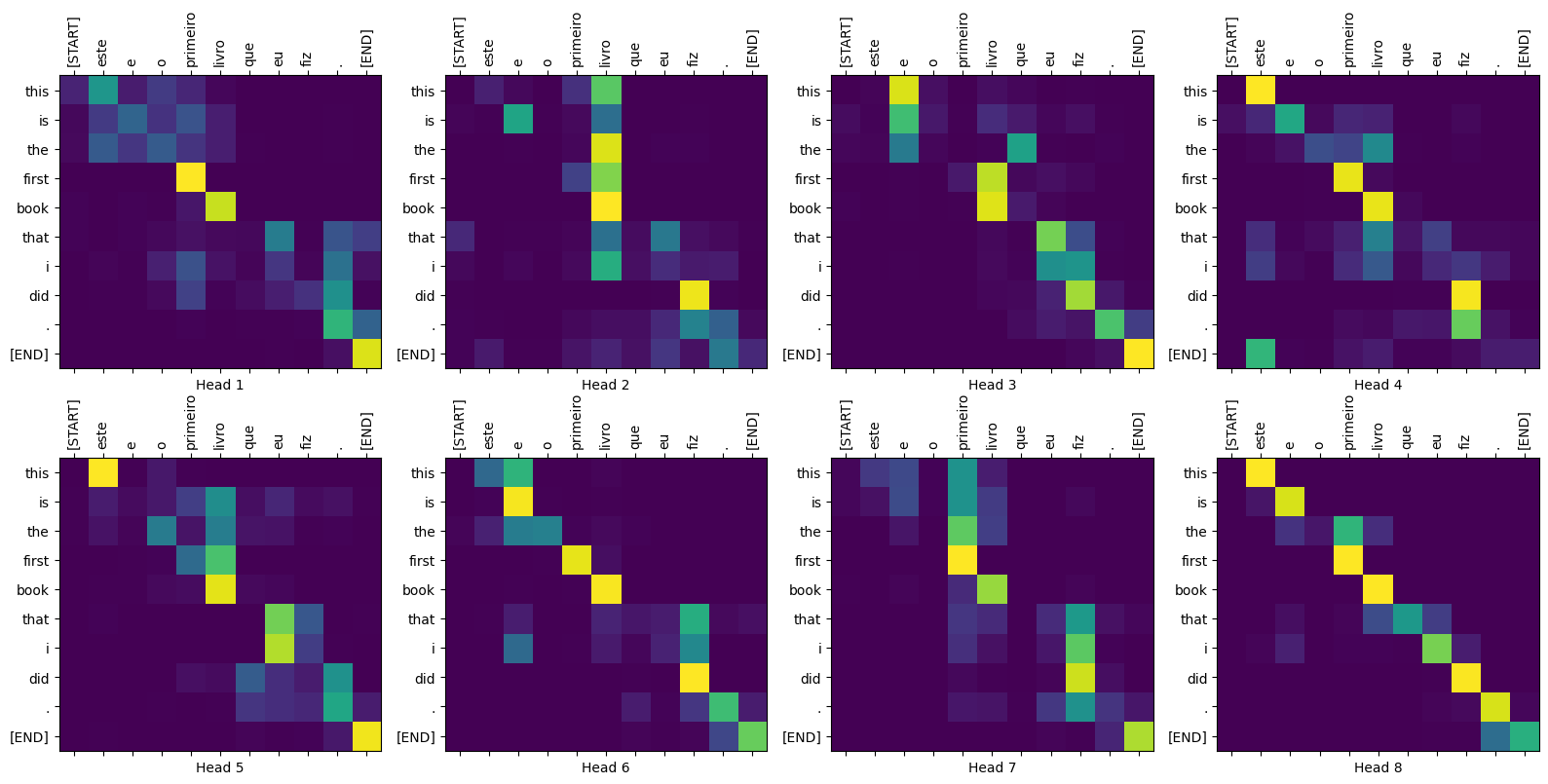
!pip install -q tf-nightly
import tensorflow_datasets as tfds
import tensorflow as tf
import time
import numpy as np
import matplotlib.pyplot as plt
入力パイプラインの設定
TFDSを使って、TED Talks Open Translation ProjectからPortugese-English translation datasetをロードします。
このデータセットには、約50000の訓練用サンプルと、1100の検証用サンプル、2000のテスト用サンプルが含まれています。
examples, metadata = tfds.load('ted_hrlr_translate/pt_to_en', with_info=True,
as_supervised=True)
train_examples, val_examples = examples['train'], examples['validation']
Downloading and preparing dataset ted_hrlr_translate/pt_to_en/1.0.0 (download: 124.94 MiB, generated: Unknown size, total: 124.94 MiB) to /home/kbuilder/tensorflow_datasets/ted_hrlr_translate/pt_to_en/1.0.0... Shuffling and writing examples to /home/kbuilder/tensorflow_datasets/ted_hrlr_translate/pt_to_en/1.0.0.incompleteQB7R3G/ted_hrlr_translate-train.tfrecord Shuffling and writing examples to /home/kbuilder/tensorflow_datasets/ted_hrlr_translate/pt_to_en/1.0.0.incompleteQB7R3G/ted_hrlr_translate-validation.tfrecord Shuffling and writing examples to /home/kbuilder/tensorflow_datasets/ted_hrlr_translate/pt_to_en/1.0.0.incompleteQB7R3G/ted_hrlr_translate-test.tfrecord Dataset ted_hrlr_translate downloaded and prepared to /home/kbuilder/tensorflow_datasets/ted_hrlr_translate/pt_to_en/1.0.0. Subsequent calls will reuse this data.
訓練用データセットから、カスタムのサブワード・トークナイザーを作成します。
tokenizer_en = tfds.features.text.SubwordTextEncoder.build_from_corpus(
(en.numpy() for pt, en in train_examples), target_vocab_size=2**13)
tokenizer_pt = tfds.features.text.SubwordTextEncoder.build_from_corpus(
(pt.numpy() for pt, en in train_examples), target_vocab_size=2**13)
sample_string = 'Transformer is awesome.'
tokenized_string = tokenizer_en.encode(sample_string)
print ('Tokenized string is {}'.format(tokenized_string))
original_string = tokenizer_en.decode(tokenized_string)
print ('The original string: {}'.format(original_string))
assert original_string == sample_string
Tokenized string is [7915, 1248, 7946, 7194, 13, 2799, 7877] The original string: Transformer is awesome.
このトークナイザーは、単語が辞書にない場合には文字列をサブワードに分解してエンコードします。
for ts in tokenized_string:
print ('{} ----> {}'.format(ts, tokenizer_en.decode([ts])))
7915 ----> T 1248 ----> ran 7946 ----> s 7194 ----> former 13 ----> is 2799 ----> awesome 7877 ----> .
BUFFER_SIZE = 20000
BATCH_SIZE = 64
入力とターゲットに開始及び終了トークンを追加します。
def encode(lang1, lang2):
lang1 = [tokenizer_pt.vocab_size] + tokenizer_pt.encode(
lang1.numpy()) + [tokenizer_pt.vocab_size+1]
lang2 = [tokenizer_en.vocab_size] + tokenizer_en.encode(
lang2.numpy()) + [tokenizer_en.vocab_size+1]
return lang1, lang2
データセットの各要素にこの関数を適用するために、Dataset.mapを使いたいと思います。Dataset.mapはグラフモードで動作します。
- グラフテンソルは値を持ちません。
- グラフモードでは、TensorFlowの演算と関数しか使えません。
このため、この関数を直接.mapすることはできません。tf.py_functionでラップする必要があります。tf.py_functionは(値とそれにアクセスするための.numpy()メソッドを持つ)通常のテンソルを、ラップされたPython関数に渡します。
def tf_encode(pt, en):
result_pt, result_en = tf.py_function(encode, [pt, en], [tf.int64, tf.int64])
result_pt.set_shape([None])
result_en.set_shape([None])
return result_pt, result_en
MAX_LENGTH = 40
def filter_max_length(x, y, max_length=MAX_LENGTH):
return tf.logical_and(tf.size(x) <= max_length,
tf.size(y) <= max_length)
train_preprocessed = (
train_examples
.map(tf_encode)
.filter(filter_max_length)
# 読み取り時のスピードアップのため、データセットをメモリ上にキャッシュする
.cache()
.shuffle(BUFFER_SIZE))
val_preprocessed = (
val_examples
.map(tf_encode)
.filter(filter_max_length))
パディングとバッチ化の両方を行います。
train_dataset = (train_preprocessed
.padded_batch(BATCH_SIZE, padded_shapes=([None], [None]))
.prefetch(tf.data.experimental.AUTOTUNE))
val_dataset = (val_preprocessed
.padded_batch(BATCH_SIZE, padded_shapes=([None], [None])))
train_dataset = (train_preprocessed
.padded_batch(BATCH_SIZE)
.prefetch(tf.data.experimental.AUTOTUNE))
val_dataset = (val_preprocessed
.padded_batch(BATCH_SIZE))
後でコードをテストするために、検証用データセットからバッチを一つ取得しておきます。
pt_batch, en_batch = next(iter(val_dataset))
pt_batch, en_batch
(<tf.Tensor: shape=(64, 38), dtype=int64, numpy=
array([[8214, 342, 3032, ..., 0, 0, 0],
[8214, 95, 198, ..., 0, 0, 0],
[8214, 4479, 7990, ..., 0, 0, 0],
...,
[8214, 584, 12, ..., 0, 0, 0],
[8214, 59, 1548, ..., 0, 0, 0],
[8214, 118, 34, ..., 0, 0, 0]])>,
<tf.Tensor: shape=(64, 40), dtype=int64, numpy=
array([[8087, 98, 25, ..., 0, 0, 0],
[8087, 12, 20, ..., 0, 0, 0],
[8087, 12, 5453, ..., 0, 0, 0],
...,
[8087, 18, 2059, ..., 0, 0, 0],
[8087, 16, 1436, ..., 0, 0, 0],
[8087, 15, 57, ..., 0, 0, 0]])>)
位置エンコーディング
このモデルには再帰や畳込みが含まれないので、モデルに文中の単語の相対的な位置の情報を与えるため、位置エンコーディングを追加します。
位置エンコーディングベクトルは埋め込みベクトルに加算します。埋め込みはトークンをd次元空間で表現します。そこでは、同じような意味を持つトークンが近くに位置することになります。しかし、埋め込みは単語の文中の相対的位置をエンコードしません。したがって、位置エンコーディングを加えることで、単語は、d次元空間の中で、意味と文中の位置の近さにもとづいて近くに位置づけられます。
もう少し知りたければ 位置エンコーディング のノートブックを参照してください。位置エンコーディングを計算する式は下記のとおりです。
\[\Large{PE_{(pos, 2i)} = sin(pos / 10000^{2i / d_{model} })} \]
\[\Large{PE_{(pos, 2i+1)} = cos(pos / 10000^{2i / d_{model} })} \]
def get_angles(pos, i, d_model):
angle_rates = 1 / np.power(10000, (2 * (i//2)) / np.float32(d_model))
return pos * angle_rates
def positional_encoding(position, d_model):
angle_rads = get_angles(np.arange(position)[:, np.newaxis],
np.arange(d_model)[np.newaxis, :],
d_model)
# 配列中の偶数インデックスにはsinを適用; 2i
angle_rads[:, 0::2] = np.sin(angle_rads[:, 0::2])
# 配列中の奇数インデックスにはcosを適用; 2i+1
angle_rads[:, 1::2] = np.cos(angle_rads[:, 1::2])
pos_encoding = angle_rads[np.newaxis, ...]
return tf.cast(pos_encoding, dtype=tf.float32)
pos_encoding = positional_encoding(50, 512)
print (pos_encoding.shape)
plt.pcolormesh(pos_encoding[0], cmap='RdBu')
plt.xlabel('Depth')
plt.xlim((0, 512))
plt.ylabel('Position')
plt.colorbar()
plt.show()
(1, 50, 512)
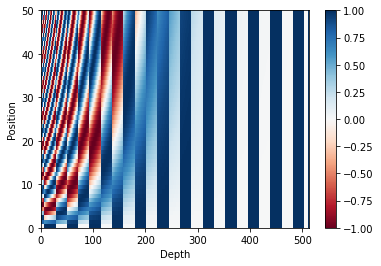
マスキング
シーケンスのバッチ中のパディングされた全てのトークンをマスクします。これにより、モデルがパディングを確実に入力として扱わないようにします。マスクは、パディング値0の存在を示します。つまり、0の場所で1を出力し、それ以外の場所では0を出力します。
def create_padding_mask(seq):
seq = tf.cast(tf.math.equal(seq, 0), tf.float32)
# アテンション・ロジットにパディングを追加するため
# さらに次元を追加する
return seq[:, tf.newaxis, tf.newaxis, :] # (batch_size, 1, 1, seq_len)
x = tf.constant([[7, 6, 0, 0, 1], [1, 2, 3, 0, 0], [0, 0, 0, 4, 5]])
create_padding_mask(x)
<tf.Tensor: shape=(3, 1, 1, 5), dtype=float32, numpy=
array([[[[0., 0., 1., 1., 0.]]],
[[[0., 0., 0., 1., 1.]]],
[[[1., 1., 1., 0., 0.]]]], dtype=float32)>
シーケンス中の未来のトークンをマスクするため、 ルックアヘッド・マスクが使われています。言い換えると、このマスクはどのエントリーを使うべきではないかを示しています。
これは、3番めの単語を予測するために、1つ目と2つ目の単語だけが使われるということを意味しています。同じように4つ目の単語を予測するには、1つ目、2つ目と3つ目の単語だけが使用され、次も同様となります。
def create_look_ahead_mask(size):
mask = 1 - tf.linalg.band_part(tf.ones((size, size)), -1, 0)
return mask # (seq_len, seq_len)
x = tf.random.uniform((1, 3))
temp = create_look_ahead_mask(x.shape[1])
temp
<tf.Tensor: shape=(3, 3), dtype=float32, numpy=
array([[0., 1., 1.],
[0., 0., 1.],
[0., 0., 0.]], dtype=float32)>
スケール済み内積アテンション
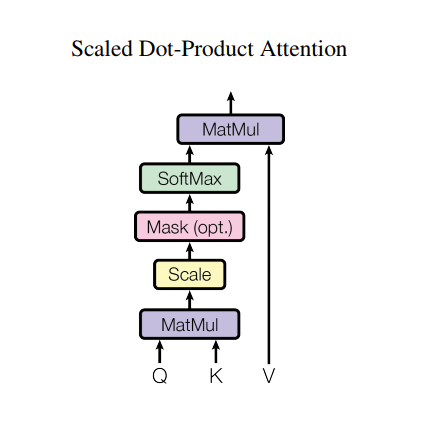
Transformerで使われているアテンション関数は3つの入力;Q(query), K(key), V(value)を取ります。このアテンションの重みの計算に使われている式は下記の通りです。
\[\Large{Attention(Q, K, V) = softmax_k(\frac{QK^T}{\sqrt{d_k} }) V} \]
内積アテンションは、深度の平方根をファクターとしてスケールされています。これは、深度が大きくなると、内積が非常に大きくなり、ソフトマックス関数の勾配を計算すると非常に小さな値しか返さなくなってしまうためです。
例えば、QとKが平均0分散1だと思ってください。これらの行列積は、平均0分散はdkとなります。したがって、(他の数字ではなく)dkの平方根をスケーリングに使うことで、Q と K の行列積においても平均 0 分散 1 となり、緩やかな勾配を持つソフトマックスが得られることが期待できるのです。
マスクには、(負の無限大に近い)-1e9が掛けられています。これは、マスクがQとKのスケール済み行列積と合計され、ソフトマックスの直前に適用されるからです。目的は、これらのセルをゼロにしてしまうことで、大きなマイナスの入力は、ゼロに近い出力となります。
def scaled_dot_product_attention(q, k, v, mask):
"""アテンションの重みの計算
q, k, vは最初の次元が一致していること
k, vは最後から2番めの次元が一致していること
マスクは型(パディングかルックアヘッドか)によって異なるshapeを持つが、
加算の際にブロードキャスト可能であること
引数:
q: query shape == (..., seq_len_q, depth)
k: key shape == (..., seq_len_k, depth)
v: value shape == (..., seq_len_v, depth_v)
mask: (..., seq_len_q, seq_len_k) にブロードキャスト可能な
shapeを持つ浮動小数点テンソル。既定値はNone
戻り値:
出力、アテンションの重み
"""
matmul_qk = tf.matmul(q, k, transpose_b=True) # (..., seq_len_q, seq_len_k)
# matmul_qkをスケール
dk = tf.cast(tf.shape(k)[-1], tf.float32)
scaled_attention_logits = matmul_qk / tf.math.sqrt(dk)
# マスクをスケール済みテンソルに加算
if mask is not None:
scaled_attention_logits += (mask * -1e9)
# softmax は最後の軸(seq_len_k)について
# 合計が1となるように正規化
attention_weights = tf.nn.softmax(scaled_attention_logits, axis=-1) # (..., seq_len_q, seq_len_k)
output = tf.matmul(attention_weights, v) # (..., seq_len_q, depth_v)
return output, attention_weights
ソフトマックス正規化がKに対して行われるため、その値がQに割り当てる重要度を決めることになります。
出力は、アテンションの重みとV(value)ベクトルの積を表しています。これにより、注目したい単語がそのまま残され、それ以外の単語は破棄されます。
def print_out(q, k, v):
temp_out, temp_attn = scaled_dot_product_attention(
q, k, v, None)
print ('Attention weights are:')
print (temp_attn)
print ('Output is:')
print (temp_out)
np.set_printoptions(suppress=True)
temp_k = tf.constant([[10,0,0],
[0,10,0],
[0,0,10],
[0,0,10]], dtype=tf.float32) # (4, 3)
temp_v = tf.constant([[ 1,0],
[ 10,0],
[ 100,5],
[1000,6]], dtype=tf.float32) # (4, 2)
# この`query`は2番目の`key`に割り付けられているので
# 2番めの`value`が返される
temp_q = tf.constant([[0, 10, 0]], dtype=tf.float32) # (1, 3)
print_out(temp_q, temp_k, temp_v)
Attention weights are: tf.Tensor([[0. 1. 0. 0.]], shape=(1, 4), dtype=float32) Output is: tf.Tensor([[10. 0.]], shape=(1, 2), dtype=float32)
# このクエリは(3番目と 4番目の)繰り返しキーに割り付けられるので
# 関連した全ての値が平均される
temp_q = tf.constant([[0, 0, 10]], dtype=tf.float32) # (1, 3)
print_out(temp_q, temp_k, temp_v)
Attention weights are: tf.Tensor([[0. 0. 0.5 0.5]], shape=(1, 4), dtype=float32) Output is: tf.Tensor([[550. 5.5]], shape=(1, 2), dtype=float32)
# このクエリは最初と2番めのキーに等しく割り付けられるので
# それらの値が平均される
temp_q = tf.constant([[10, 10, 0]], dtype=tf.float32) # (1, 3)
print_out(temp_q, temp_k, temp_v)
Attention weights are: tf.Tensor([[0.5 0.5 0. 0. ]], shape=(1, 4), dtype=float32) Output is: tf.Tensor([[5.5 0. ]], shape=(1, 2), dtype=float32)
すべてのクエリをまとめます。
temp_q = tf.constant([[0, 0, 10], [0, 10, 0], [10, 10, 0]], dtype=tf.float32) # (3, 3)
print_out(temp_q, temp_k, temp_v)
Attention weights are: tf.Tensor( [[0. 0. 0.5 0.5] [0. 1. 0. 0. ] [0.5 0.5 0. 0. ]], shape=(3, 4), dtype=float32) Output is: tf.Tensor( [[550. 5.5] [ 10. 0. ] [ 5.5 0. ]], shape=(3, 2), dtype=float32)
マルチヘッド・アテンション
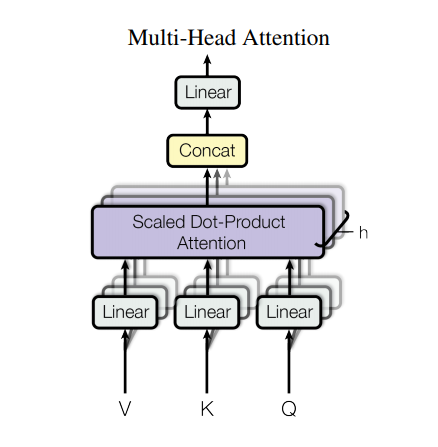
マルチヘッド・アテンションは4つのパートから成っています。
- 線形レイヤーとマルチヘッドへの分割
- スケール済み内積アテンション
- マルチヘッドの結合
- 最終線形レイヤー
各マルチヘッド・アテンション・ブロックは3つの入力:Q(query), K(key), V(value)を取ります。 これらは、線形(Dense)レイヤーを通され、マルチヘッドに分割されます。
上記で定義したscaled_dot_product_attentionは(効率のためにブロードキャストで)各ヘッドに適用されます。アテンション・ステップにおいては、適切なマスクを使用しなければなりません。その後、各ヘッドのアテンション出力は(tf.transposeとtf.reshapeを使って)結合され、最後のDenseレイヤーに通されます。
単一のアテンション・ヘッドのかわりに、Q、K、およびVは複数のヘッドに分割されます。なぜなら、それによって、モデルが異なる表現空間の異なる位置の情報について、連携してアテンションを計算できるからです。また、分割後の各ヘッドの次元を小さくすることで、全体の計算コストを、すべての次元を持つ単一のアテンション・ヘッドを用いた場合と同一にできます。
class MultiHeadAttention(tf.keras.layers.Layer):
def __init__(self, d_model, num_heads):
super(MultiHeadAttention, self).__init__()
self.num_heads = num_heads
self.d_model = d_model
assert d_model % self.num_heads == 0
self.depth = d_model // self.num_heads
self.wq = tf.keras.layers.Dense(d_model)
self.wk = tf.keras.layers.Dense(d_model)
self.wv = tf.keras.layers.Dense(d_model)
self.dense = tf.keras.layers.Dense(d_model)
def split_heads(self, x, batch_size):
"""最後の次元を(num_heads, depth)に分割。
結果をshapeが(batch_size, num_heads, seq_len, depth)となるようにリシェイプする。
"""
x = tf.reshape(x, (batch_size, -1, self.num_heads, self.depth))
return tf.transpose(x, perm=[0, 2, 1, 3])
def call(self, v, k, q, mask):
batch_size = tf.shape(q)[0]
q = self.wq(q) # (batch_size, seq_len, d_model)
k = self.wk(k) # (batch_size, seq_len, d_model)
v = self.wv(v) # (batch_size, seq_len, d_model)
q = self.split_heads(q, batch_size) # (batch_size, num_heads, seq_len_q, depth)
k = self.split_heads(k, batch_size) # (batch_size, num_heads, seq_len_k, depth)
v = self.split_heads(v, batch_size) # (batch_size, num_heads, seq_len_v, depth)
# scaled_attention.shape == (batch_size, num_heads, seq_len_q, depth)
# attention_weights.shape == (batch_size, num_heads, seq_len_q, seq_len_k)
scaled_attention, attention_weights = scaled_dot_product_attention(
q, k, v, mask)
scaled_attention = tf.transpose(scaled_attention, perm=[0, 2, 1, 3]) # (batch_size, seq_len_q, num_heads, depth)
concat_attention = tf.reshape(scaled_attention,
(batch_size, -1, self.d_model)) # (batch_size, seq_len_q, d_model)
output = self.dense(concat_attention) # (batch_size, seq_len_q, d_model)
return output, attention_weights
試しに、MultiHeadAttentionレイヤーを作ってみましょう。シーケンス y の各位置において、MultiHeadAttention はシーケンスのすべての位置に対して8つのヘッドを用いてアテンションを計算し、各位置それぞれで同じ長さの新しいベクトルを返します。
temp_mha = MultiHeadAttention(d_model=512, num_heads=8)
y = tf.random.uniform((1, 60, 512)) # (batch_size, encoder_sequence, d_model)
out, attn = temp_mha(y, k=y, q=y, mask=None)
out.shape, attn.shape
(TensorShape([1, 60, 512]), TensorShape([1, 8, 60, 60]))
ポイントワイズのフィードフォワード・ネットワーク
ポイントワイズのフィードフォワード・ネットワークは、2つの全結合層とそれをつなぐReLU活性化層からなります。
def point_wise_feed_forward_network(d_model, dff):
return tf.keras.Sequential([
tf.keras.layers.Dense(dff, activation='relu'), # (batch_size, seq_len, dff)
tf.keras.layers.Dense(d_model) # (batch_size, seq_len, d_model)
])
sample_ffn = point_wise_feed_forward_network(512, 2048)
sample_ffn(tf.random.uniform((64, 50, 512))).shape
TensorShape([64, 50, 512])
エンコーダーとデコーダー
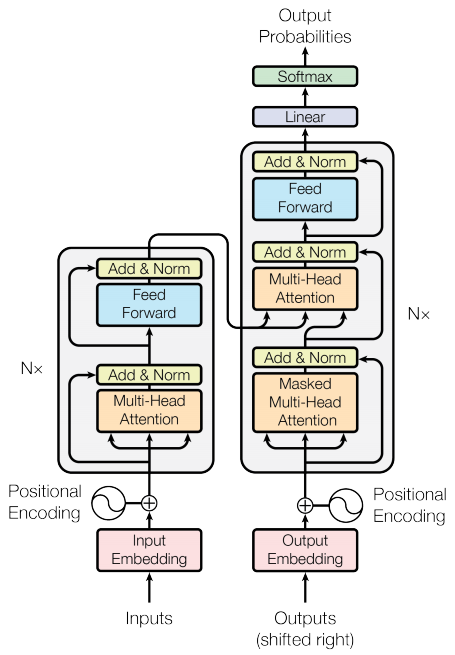
Transformerモデルは、標準のアテンション付きシーケンス・トゥー・シーケンスモデルと同じ一般的なパターンを踏襲します。
- 入力の文は、
N層のエンコーダー・レイヤーを通り、シーケンス中の単語/トークンごとに出力を生成する。 - デコーダーは、エンコーダーの出力と自分自身の入力(セルフアテンション)に注目し、次の単語を予測する。
エンコーダー・レイヤー
それぞれのエンコーダー・レイヤーは次のようなサブレイヤーから成っています。
- マルチヘッド・アテンション(パディング・マスク付き)
- ポイントワイズ・フィードフォワード・ネットワーク
サブレイヤーにはそれぞれ残差接続があり、その後にレイヤー正規化が続きます。残差接続は、深いネットワークでの勾配消失問題を回避するのに役立ちます。
それぞれのサブレイヤーの出力はLayerNorm(x + Sublayer(x))です。正規化は、(最後の)d_model軸に対して行われます。TransformerにはN層のエンコーダーがあります。
class EncoderLayer(tf.keras.layers.Layer):
def __init__(self, d_model, num_heads, dff, rate=0.1):
super(EncoderLayer, self).__init__()
self.mha = MultiHeadAttention(d_model, num_heads)
self.ffn = point_wise_feed_forward_network(d_model, dff)
self.layernorm1 = tf.keras.layers.LayerNormalization(epsilon=1e-6)
self.layernorm2 = tf.keras.layers.LayerNormalization(epsilon=1e-6)
self.dropout1 = tf.keras.layers.Dropout(rate)
self.dropout2 = tf.keras.layers.Dropout(rate)
def call(self, x, training, mask):
attn_output, _ = self.mha(x, x, x, mask) # (batch_size, input_seq_len, d_model)
attn_output = self.dropout1(attn_output, training=training)
out1 = self.layernorm1(x + attn_output) # (batch_size, input_seq_len, d_model)
ffn_output = self.ffn(out1) # (batch_size, input_seq_len, d_model)
ffn_output = self.dropout2(ffn_output, training=training)
out2 = self.layernorm2(out1 + ffn_output) # (batch_size, input_seq_len, d_model)
return out2
sample_encoder_layer = EncoderLayer(512, 8, 2048)
sample_encoder_layer_output = sample_encoder_layer(
tf.random.uniform((64, 43, 512)), False, None)
sample_encoder_layer_output.shape # (batch_size, input_seq_len, d_model)
TensorShape([64, 43, 512])
デコーダー・レイヤー
各デコーダー・レイヤーは次のようなサブレイヤーからなります。
- マスク付きマルチヘッド・アテンション( ルックアヘッド・マスクおよびパディング・マスク付き)
- (パディング・マスク付き)マルチヘッド・アテンション。V(value) と K(key) はエンコーダーの出力を入力として受け取る。Q(query)はマスク付きマルチヘッド・アテンション・サブレイヤーの出力を受け取る。
- ポイントワイズ・フィードフォワード・ネットワーク
各サブレイヤーは残差接続を持ち、その後にレイヤー正規化が続きます。各サブレイヤーの出力はLayerNorm(x + Sublayer(x))です。正規化は、(最後の)d_model軸に沿って行われます。
Transformerには、N層のデコーダー・レイヤーが存在します。
Qがデコーダーの最初のアテンション・ブロックの出力を受け取り、Kがエンコーダーの出力を受け取るとき、アテンションの重みは、デコーダーの入力の、エンコーダーの出力に対する重要度を表します。言い換えると、デコーダーは、エンコーダーの出力と自分自身の出力のセルフ・アテンションを見て、次の単語を予想します。上記の、スケール済み内積アテンションのセクションのデモを参照してください。
class DecoderLayer(tf.keras.layers.Layer):
def __init__(self, d_model, num_heads, dff, rate=0.1):
super(DecoderLayer, self).__init__()
self.mha1 = MultiHeadAttention(d_model, num_heads)
self.mha2 = MultiHeadAttention(d_model, num_heads)
self.ffn = point_wise_feed_forward_network(d_model, dff)
self.layernorm1 = tf.keras.layers.LayerNormalization(epsilon=1e-6)
self.layernorm2 = tf.keras.layers.LayerNormalization(epsilon=1e-6)
self.layernorm3 = tf.keras.layers.LayerNormalization(epsilon=1e-6)
self.dropout1 = tf.keras.layers.Dropout(rate)
self.dropout2 = tf.keras.layers.Dropout(rate)
self.dropout3 = tf.keras.layers.Dropout(rate)
def call(self, x, enc_output, training,
look_ahead_mask, padding_mask):
# enc_output.shape == (batch_size, input_seq_len, d_model)
attn1, attn_weights_block1 = self.mha1(x, x, x, look_ahead_mask) # (batch_size, target_seq_len, d_model)
attn1 = self.dropout1(attn1, training=training)
out1 = self.layernorm1(attn1 + x)
attn2, attn_weights_block2 = self.mha2(
enc_output, enc_output, out1, padding_mask) # (batch_size, target_seq_len, d_model)
attn2 = self.dropout2(attn2, training=training)
out2 = self.layernorm2(attn2 + out1) # (batch_size, target_seq_len, d_model)
ffn_output = self.ffn(out2) # (batch_size, target_seq_len, d_model)
ffn_output = self.dropout3(ffn_output, training=training)
out3 = self.layernorm3(ffn_output + out2) # (batch_size, target_seq_len, d_model)
return out3, attn_weights_block1, attn_weights_block2
sample_decoder_layer = DecoderLayer(512, 8, 2048)
sample_decoder_layer_output, _, _ = sample_decoder_layer(
tf.random.uniform((64, 50, 512)), sample_encoder_layer_output,
False, None, None)
sample_decoder_layer_output.shape # (batch_size, target_seq_len, d_model)
TensorShape([64, 50, 512])
エンコーダー
Encoderは次のものからできています。
- 入力の埋め込み
- 位置エンコーディング
- N 層のエンコーダー・レイヤー
入力は埋め込み層を通り、位置エンコーディングと合算されます。この加算の出力がエンコーダー・レイヤーの入力です。エンコーダーの出力はデコーダーの入力になります。
class Encoder(tf.keras.layers.Layer):
def __init__(self, num_layers, d_model, num_heads, dff, input_vocab_size,
maximum_position_encoding, rate=0.1):
super(Encoder, self).__init__()
self.d_model = d_model
self.num_layers = num_layers
self.embedding = tf.keras.layers.Embedding(input_vocab_size, d_model)
self.pos_encoding = positional_encoding(maximum_position_encoding,
self.d_model)
self.enc_layers = [EncoderLayer(d_model, num_heads, dff, rate)
for _ in range(num_layers)]
self.dropout = tf.keras.layers.Dropout(rate)
def call(self, x, training, mask):
seq_len = tf.shape(x)[1]
# 埋め込みと位置エンコーディングを合算する
x = self.embedding(x) # (batch_size, input_seq_len, d_model)
x *= tf.math.sqrt(tf.cast(self.d_model, tf.float32))
x += self.pos_encoding[:, :seq_len, :]
x = self.dropout(x, training=training)
for i in range(self.num_layers):
x = self.enc_layers[i](x, training, mask)
return x # (batch_size, input_seq_len, d_model)
sample_encoder = Encoder(num_layers=2, d_model=512, num_heads=8,
dff=2048, input_vocab_size=8500,
maximum_position_encoding=10000)
temp_input = tf.random.uniform((64, 62), dtype=tf.int64, minval=0, maxval=200)
sample_encoder_output = sample_encoder(temp_input, training=False, mask=None)
print (sample_encoder_output.shape) # (batch_size, input_seq_len, d_model)
(64, 62, 512)
デコーダー
Decoder は次のもとからできています。
- 出力埋め込み
- 位置エンコーディング
- N 層のデコーダー・レイヤー
ターゲットは埋め込みを通り、位置エンコーディングと加算されます。この加算の出力がデコーダーの入力になります。デコーダーの出力は、最後の線形レイヤーの入力となります。
class Decoder(tf.keras.layers.Layer):
def __init__(self, num_layers, d_model, num_heads, dff, target_vocab_size,
maximum_position_encoding, rate=0.1):
super(Decoder, self).__init__()
self.d_model = d_model
self.num_layers = num_layers
self.embedding = tf.keras.layers.Embedding(target_vocab_size, d_model)
self.pos_encoding = positional_encoding(maximum_position_encoding, d_model)
self.dec_layers = [DecoderLayer(d_model, num_heads, dff, rate)
for _ in range(num_layers)]
self.dropout = tf.keras.layers.Dropout(rate)
def call(self, x, enc_output, training,
look_ahead_mask, padding_mask):
seq_len = tf.shape(x)[1]
attention_weights = {}
x = self.embedding(x) # (batch_size, target_seq_len, d_model)
x *= tf.math.sqrt(tf.cast(self.d_model, tf.float32))
x += self.pos_encoding[:, :seq_len, :]
x = self.dropout(x, training=training)
for i in range(self.num_layers):
x, block1, block2 = self.dec_layers[i](x, enc_output, training,
look_ahead_mask, padding_mask)
attention_weights['decoder_layer{}_block1'.format(i+1)] = block1
attention_weights['decoder_layer{}_block2'.format(i+1)] = block2
# x.shape == (batch_size, target_seq_len, d_model)
return x, attention_weights
sample_decoder = Decoder(num_layers=2, d_model=512, num_heads=8,
dff=2048, target_vocab_size=8000,
maximum_position_encoding=5000)
temp_input = tf.random.uniform((64, 26), dtype=tf.int64, minval=0, maxval=200)
output, attn = sample_decoder(temp_input,
enc_output=sample_encoder_output,
training=False,
look_ahead_mask=None,
padding_mask=None)
output.shape, attn['decoder_layer2_block2'].shape
(TensorShape([64, 26, 512]), TensorShape([64, 8, 26, 62]))
Transformerの作成
Transformerは、エンコーダー、デコーダーと、最後の線形レイヤーからなります。デコーダーの出力は、線形レイヤーの入力であり、その出力が返されます。
class Transformer(tf.keras.Model):
def __init__(self, num_layers, d_model, num_heads, dff, input_vocab_size,
target_vocab_size, pe_input, pe_target, rate=0.1):
super(Transformer, self).__init__()
self.encoder = Encoder(num_layers, d_model, num_heads, dff,
input_vocab_size, pe_input, rate)
self.decoder = Decoder(num_layers, d_model, num_heads, dff,
target_vocab_size, pe_target, rate)
self.final_layer = tf.keras.layers.Dense(target_vocab_size)
def call(self, inp, tar, training, enc_padding_mask,
look_ahead_mask, dec_padding_mask):
enc_output = self.encoder(inp, training, enc_padding_mask) # (batch_size, inp_seq_len, d_model)
# dec_output.shape == (batch_size, tar_seq_len, d_model)
dec_output, attention_weights = self.decoder(
tar, enc_output, training, look_ahead_mask, dec_padding_mask)
final_output = self.final_layer(dec_output) # (batch_size, tar_seq_len, target_vocab_size)
return final_output, attention_weights
sample_transformer = Transformer(
num_layers=2, d_model=512, num_heads=8, dff=2048,
input_vocab_size=8500, target_vocab_size=8000,
pe_input=10000, pe_target=6000)
temp_input = tf.random.uniform((64, 38), dtype=tf.int64, minval=0, maxval=200)
temp_target = tf.random.uniform((64, 36), dtype=tf.int64, minval=0, maxval=200)
fn_out, _ = sample_transformer(temp_input, temp_target, training=False,
enc_padding_mask=None,
look_ahead_mask=None,
dec_padding_mask=None)
fn_out.shape # (batch_size, tar_seq_len, target_vocab_size)
TensorShape([64, 36, 8000])
ハイパーパラメーターの設定
このサンプルを小さく、比較的高速にするため、 num_layers, d_model, and dffの値は小さくされています。
Transformerのベースモデルで使われている値はnum_layers=6, d_model = 512, dff = 2048です。 Transformerの他のバージョンについては、論文を参照してください。
num_layers = 4
d_model = 128
dff = 512
num_heads = 8
input_vocab_size = tokenizer_pt.vocab_size + 2
target_vocab_size = tokenizer_en.vocab_size + 2
dropout_rate = 0.1
オプティマイザー
論文の中の式に従って、カスタムの学習率スケジューラーを持った、Adamオプティマイザーを使用します。
\[\Large{lrate = d_{model}^{-0.5} * min(step{\_}num^{-0.5}, step{\_}num * warmup{\_}steps^{-1.5})}\]
class CustomSchedule(tf.keras.optimizers.schedules.LearningRateSchedule):
def __init__(self, d_model, warmup_steps=4000):
super(CustomSchedule, self).__init__()
self.d_model = d_model
self.d_model = tf.cast(self.d_model, tf.float32)
self.warmup_steps = warmup_steps
def __call__(self, step):
arg1 = tf.math.rsqrt(step)
arg2 = step * (self.warmup_steps ** -1.5)
return tf.math.rsqrt(self.d_model) * tf.math.minimum(arg1, arg2)
learning_rate = CustomSchedule(d_model)
optimizer = tf.keras.optimizers.Adam(learning_rate, beta_1=0.9, beta_2=0.98,
epsilon=1e-9)
temp_learning_rate_schedule = CustomSchedule(d_model)
plt.plot(temp_learning_rate_schedule(tf.range(40000, dtype=tf.float32)))
plt.ylabel("Learning Rate")
plt.xlabel("Train Step")
Text(0.5, 0, 'Train Step')
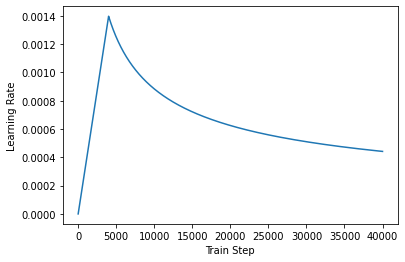
損失とメトリクス
ターゲットシーケンスはパディングされているため、損失を計算する際にパディング・マスクを適用することが重要です。
loss_object = tf.keras.losses.SparseCategoricalCrossentropy(
from_logits=True, reduction='none')
def loss_function(real, pred):
mask = tf.math.logical_not(tf.math.equal(real, 0))
loss_ = loss_object(real, pred)
mask = tf.cast(mask, dtype=loss_.dtype)
loss_ *= mask
return tf.reduce_mean(loss_)
train_loss = tf.keras.metrics.Mean(name='train_loss')
train_accuracy = tf.keras.metrics.SparseCategoricalAccuracy(
name='train_accuracy')
訓練とチェックポイント生成
transformer = Transformer(num_layers, d_model, num_heads, dff,
input_vocab_size, target_vocab_size,
pe_input=input_vocab_size,
pe_target=target_vocab_size,
rate=dropout_rate)
def create_masks(inp, tar):
# Encoderパディング・マスク
enc_padding_mask = create_padding_mask(inp)
# デコーダーの 2つ目のアテンション・ブロックで使用
# このパディング・マスクはエンコーダーの出力をマスクするのに使用
dec_padding_mask = create_padding_mask(inp)
# デコーダーの 1つ目のアテンション・ブロックで使用
# デコーダーが受け取った入力のパディングと将来のトークンをマスクするのに使用
look_ahead_mask = create_look_ahead_mask(tf.shape(tar)[1])
dec_target_padding_mask = create_padding_mask(tar)
combined_mask = tf.maximum(dec_target_padding_mask, look_ahead_mask)
return enc_padding_mask, combined_mask, dec_padding_mask
チェックポイントのパスとチェックポイント・マネージャーを作成します。これは、nエポックごとにチェックポイントを保存するのに使用されます。
checkpoint_path = "./checkpoints/train"
ckpt = tf.train.Checkpoint(transformer=transformer,
optimizer=optimizer)
ckpt_manager = tf.train.CheckpointManager(ckpt, checkpoint_path, max_to_keep=5)
# チェックポイントが存在したなら、最後のチェックポイントを復元
if ckpt_manager.latest_checkpoint:
ckpt.restore(ckpt_manager.latest_checkpoint)
print ('Latest checkpoint restored!!')
ターゲットは、tar_inpとtar_realに分けられます。tar_inpはデコーダーの入力として渡されます。tar_realは同じ入力を1つシフトしたものです。tar_inputの位置それぞれで、tar_realは予測されるべき次のトークンを含んでいます。
たとえば、sentence = "SOS A lion in the jungle is sleeping EOS" だとすると、次のようになります。
tar_inp = "SOS A lion in the jungle is sleeping"
tar_real = "A lion in the jungle is sleeping EOS"
Transformerは、自己回帰モデルです。1回に1箇所の予測を行い、その出力を次に何をすべきかの判断に使用します。
訓練時にこのサンプルはテキスト生成チュートリアルのように、ティーチャーフォーシングを使用します。ティーチャーフォーシングとは、その時点においてモデルが何を予測したかに関わらず、真の出力を次のステップに渡すというものです。
Transformerが単語を予測するたびに、セルフアテンションのおかげで次の単語を予測するために入力シーケンスの過去の単語を参照することができます。
モデルが期待される出力を盗み見ることがないように、モデルはルックアヘッド・マスクを使用します。
EPOCHS = 20
# @tf.functionは高速に実行するためにtrain_stepをTFグラフにトレースコンパイルします。
# この関数は、引数となるテンソルのshapeに特化したものです。
# シーケンスの長さや(最後のバッチが小さくなるなど)バッチサイズが可変となることによって
# 再トレーシングが起きないようにするため、input_signatureを使って、より一般的なshapeを
# 指定します。
train_step_signature = [
tf.TensorSpec(shape=(None, None), dtype=tf.int64),
tf.TensorSpec(shape=(None, None), dtype=tf.int64),
]
@tf.function(input_signature=train_step_signature)
def train_step(inp, tar):
tar_inp = tar[:, :-1]
tar_real = tar[:, 1:]
enc_padding_mask, combined_mask, dec_padding_mask = create_masks(inp, tar_inp)
with tf.GradientTape() as tape:
predictions, _ = transformer(inp, tar_inp,
True,
enc_padding_mask,
combined_mask,
dec_padding_mask)
loss = loss_function(tar_real, predictions)
gradients = tape.gradient(loss, transformer.trainable_variables)
optimizer.apply_gradients(zip(gradients, transformer.trainable_variables))
train_loss(loss)
train_accuracy(tar_real, predictions)
ポルトガル語を入力言語とし、英語をターゲット言語とします。
for epoch in range(EPOCHS):
start = time.time()
train_loss.reset_states()
train_accuracy.reset_states()
# inp -> portuguese, tar -> english
for (batch, (inp, tar)) in enumerate(train_dataset):
train_step(inp, tar)
if batch % 50 == 0:
print ('Epoch {} Batch {} Loss {:.4f} Accuracy {:.4f}'.format(
epoch + 1, batch, train_loss.result(), train_accuracy.result()))
if (epoch + 1) % 5 == 0:
ckpt_save_path = ckpt_manager.save()
print ('Saving checkpoint for epoch {} at {}'.format(epoch+1,
ckpt_save_path))
print ('Epoch {} Loss {:.4f} Accuracy {:.4f}'.format(epoch + 1,
train_loss.result(),
train_accuracy.result()))
print ('Time taken for 1 epoch: {} secs\n'.format(time.time() - start))
Epoch 1 Batch 0 Loss 3.9763 Accuracy 0.0004 Epoch 1 Batch 50 Loss 4.2042 Accuracy 0.0004 Epoch 1 Batch 100 Loss 4.1785 Accuracy 0.0109 Epoch 1 Batch 150 Loss 4.1183 Accuracy 0.0151 Epoch 1 Batch 200 Loss 4.0503 Accuracy 0.0172 Epoch 1 Batch 250 Loss 3.9723 Accuracy 0.0193 Epoch 1 Batch 300 Loss 3.8883 Accuracy 0.0241 Epoch 1 Batch 350 Loss 3.7982 Accuracy 0.0277 Epoch 1 Batch 400 Loss 3.7230 Accuracy 0.0306 Epoch 1 Batch 450 Loss 3.6471 Accuracy 0.0337 Epoch 1 Batch 500 Loss 3.5798 Accuracy 0.0366 Epoch 1 Batch 550 Loss 3.5230 Accuracy 0.0393 Epoch 1 Batch 600 Loss 3.4666 Accuracy 0.0427 Epoch 1 Batch 650 Loss 3.4099 Accuracy 0.0462 Epoch 1 Batch 700 Loss 3.3593 Accuracy 0.0497 Epoch 1 Loss 3.3583 Accuracy 0.0498 Time taken for 1 epoch: 53.75345039367676 secs Epoch 2 Batch 0 Loss 2.7194 Accuracy 0.1103 Epoch 2 Batch 50 Loss 2.5624 Accuracy 0.1006 Epoch 2 Batch 100 Loss 2.5498 Accuracy 0.1042 Epoch 2 Batch 150 Loss 2.5284 Accuracy 0.1068 Epoch 2 Batch 200 Loss 2.5073 Accuracy 0.1095 Epoch 2 Batch 250 Loss 2.4913 Accuracy 0.1116 Epoch 2 Batch 300 Loss 2.4717 Accuracy 0.1136 Epoch 2 Batch 350 Loss 2.4595 Accuracy 0.1155 Epoch 2 Batch 400 Loss 2.4414 Accuracy 0.1169 Epoch 2 Batch 450 Loss 2.4266 Accuracy 0.1185 Epoch 2 Batch 500 Loss 2.4126 Accuracy 0.1202 Epoch 2 Batch 550 Loss 2.3988 Accuracy 0.1215 Epoch 2 Batch 600 Loss 2.3841 Accuracy 0.1230 Epoch 2 Batch 650 Loss 2.3705 Accuracy 0.1242 Epoch 2 Batch 700 Loss 2.3584 Accuracy 0.1254 Epoch 2 Loss 2.3572 Accuracy 0.1254 Time taken for 1 epoch: 29.322442531585693 secs Epoch 3 Batch 0 Loss 1.8321 Accuracy 0.1443 Epoch 3 Batch 50 Loss 2.1570 Accuracy 0.1440 Epoch 3 Batch 100 Loss 2.1749 Accuracy 0.1448 Epoch 3 Batch 150 Loss 2.1589 Accuracy 0.1449 Epoch 3 Batch 200 Loss 2.1527 Accuracy 0.1462 Epoch 3 Batch 250 Loss 2.1488 Accuracy 0.1464 Epoch 3 Batch 300 Loss 2.1447 Accuracy 0.1466 Epoch 3 Batch 350 Loss 2.1401 Accuracy 0.1473 Epoch 3 Batch 400 Loss 2.1405 Accuracy 0.1480 Epoch 3 Batch 450 Loss 2.1322 Accuracy 0.1486 Epoch 3 Batch 500 Loss 2.1259 Accuracy 0.1493 Epoch 3 Batch 550 Loss 2.1182 Accuracy 0.1500 Epoch 3 Batch 600 Loss 2.1105 Accuracy 0.1506 Epoch 3 Batch 650 Loss 2.1020 Accuracy 0.1514 Epoch 3 Batch 700 Loss 2.0972 Accuracy 0.1524 Epoch 3 Loss 2.0967 Accuracy 0.1524 Time taken for 1 epoch: 29.156527519226074 secs Epoch 4 Batch 0 Loss 1.8457 Accuracy 0.1516 Epoch 4 Batch 50 Loss 1.9508 Accuracy 0.1669 Epoch 4 Batch 100 Loss 1.9386 Accuracy 0.1676 Epoch 4 Batch 150 Loss 1.9383 Accuracy 0.1680 Epoch 4 Batch 200 Loss 1.9277 Accuracy 0.1686 Epoch 4 Batch 250 Loss 1.9303 Accuracy 0.1694 Epoch 4 Batch 300 Loss 1.9215 Accuracy 0.1703 Epoch 4 Batch 350 Loss 1.9135 Accuracy 0.1716 Epoch 4 Batch 400 Loss 1.9087 Accuracy 0.1725 Epoch 4 Batch 450 Loss 1.9019 Accuracy 0.1735 Epoch 4 Batch 500 Loss 1.8973 Accuracy 0.1748 Epoch 4 Batch 550 Loss 1.8924 Accuracy 0.1759 Epoch 4 Batch 600 Loss 1.8828 Accuracy 0.1769 Epoch 4 Batch 650 Loss 1.8757 Accuracy 0.1780 Epoch 4 Batch 700 Loss 1.8691 Accuracy 0.1790 Epoch 4 Loss 1.8693 Accuracy 0.1790 Time taken for 1 epoch: 29.42190384864807 secs Epoch 5 Batch 0 Loss 1.6703 Accuracy 0.1807 Epoch 5 Batch 50 Loss 1.6796 Accuracy 0.1965 Epoch 5 Batch 100 Loss 1.6863 Accuracy 0.1986 Epoch 5 Batch 150 Loss 1.6882 Accuracy 0.1986 Epoch 5 Batch 200 Loss 1.6808 Accuracy 0.1985 Epoch 5 Batch 250 Loss 1.6790 Accuracy 0.1995 Epoch 5 Batch 300 Loss 1.6757 Accuracy 0.2001 Epoch 5 Batch 350 Loss 1.6752 Accuracy 0.2007 Epoch 5 Batch 400 Loss 1.6728 Accuracy 0.2017 Epoch 5 Batch 450 Loss 1.6639 Accuracy 0.2022 Epoch 5 Batch 500 Loss 1.6627 Accuracy 0.2031 Epoch 5 Batch 550 Loss 1.6573 Accuracy 0.2038 Epoch 5 Batch 600 Loss 1.6555 Accuracy 0.2045 Epoch 5 Batch 650 Loss 1.6488 Accuracy 0.2050 Epoch 5 Batch 700 Loss 1.6452 Accuracy 0.2057 Saving checkpoint for epoch 5 at ./checkpoints/train/ckpt-1 Epoch 5 Loss 1.6450 Accuracy 0.2056 Time taken for 1 epoch: 29.40642786026001 secs Epoch 6 Batch 0 Loss 1.7069 Accuracy 0.2408 Epoch 6 Batch 50 Loss 1.4893 Accuracy 0.2178 Epoch 6 Batch 100 Loss 1.4910 Accuracy 0.2212 Epoch 6 Batch 150 Loss 1.4733 Accuracy 0.2212 Epoch 6 Batch 200 Loss 1.4792 Accuracy 0.2216 Epoch 6 Batch 250 Loss 1.4817 Accuracy 0.2219 Epoch 6 Batch 300 Loss 1.4797 Accuracy 0.2221 Epoch 6 Batch 350 Loss 1.4757 Accuracy 0.2226 Epoch 6 Batch 400 Loss 1.4757 Accuracy 0.2233 Epoch 6 Batch 450 Loss 1.4724 Accuracy 0.2236 Epoch 6 Batch 500 Loss 1.4715 Accuracy 0.2244 Epoch 6 Batch 550 Loss 1.4665 Accuracy 0.2250 Epoch 6 Batch 600 Loss 1.4639 Accuracy 0.2254 Epoch 6 Batch 650 Loss 1.4628 Accuracy 0.2258 Epoch 6 Batch 700 Loss 1.4603 Accuracy 0.2265 Epoch 6 Loss 1.4609 Accuracy 0.2265 Time taken for 1 epoch: 29.18768858909607 secs Epoch 7 Batch 0 Loss 1.4019 Accuracy 0.2582 Epoch 7 Batch 50 Loss 1.3085 Accuracy 0.2423 Epoch 7 Batch 100 Loss 1.3084 Accuracy 0.2426 Epoch 7 Batch 150 Loss 1.2960 Accuracy 0.2420 Epoch 7 Batch 200 Loss 1.2971 Accuracy 0.2429 Epoch 7 Batch 250 Loss 1.2968 Accuracy 0.2435 Epoch 7 Batch 300 Loss 1.2934 Accuracy 0.2438 Epoch 7 Batch 350 Loss 1.2883 Accuracy 0.2443 Epoch 7 Batch 400 Loss 1.2885 Accuracy 0.2452 Epoch 7 Batch 450 Loss 1.2870 Accuracy 0.2458 Epoch 7 Batch 500 Loss 1.2870 Accuracy 0.2465 Epoch 7 Batch 550 Loss 1.2845 Accuracy 0.2467 Epoch 7 Batch 600 Loss 1.2826 Accuracy 0.2473 Epoch 7 Batch 650 Loss 1.2794 Accuracy 0.2475 Epoch 7 Batch 700 Loss 1.2761 Accuracy 0.2477 Epoch 7 Loss 1.2759 Accuracy 0.2477 Time taken for 1 epoch: 29.321438550949097 secs Epoch 8 Batch 0 Loss 1.1444 Accuracy 0.2400 Epoch 8 Batch 50 Loss 1.1213 Accuracy 0.2639 Epoch 8 Batch 100 Loss 1.1158 Accuracy 0.2652 Epoch 8 Batch 150 Loss 1.1169 Accuracy 0.2652 Epoch 8 Batch 200 Loss 1.1204 Accuracy 0.2649 Epoch 8 Batch 250 Loss 1.1260 Accuracy 0.2659 Epoch 8 Batch 300 Loss 1.1238 Accuracy 0.2657 Epoch 8 Batch 350 Loss 1.1246 Accuracy 0.2661 Epoch 8 Batch 400 Loss 1.1249 Accuracy 0.2660 Epoch 8 Batch 450 Loss 1.1224 Accuracy 0.2663 Epoch 8 Batch 500 Loss 1.1219 Accuracy 0.2665 Epoch 8 Batch 550 Loss 1.1227 Accuracy 0.2666 Epoch 8 Batch 600 Loss 1.1223 Accuracy 0.2664 Epoch 8 Batch 650 Loss 1.1213 Accuracy 0.2664 Epoch 8 Batch 700 Loss 1.1212 Accuracy 0.2664 Epoch 8 Loss 1.1216 Accuracy 0.2664 Time taken for 1 epoch: 30.14285683631897 secs Epoch 9 Batch 0 Loss 1.0180 Accuracy 0.2596 Epoch 9 Batch 50 Loss 0.9972 Accuracy 0.2831 Epoch 9 Batch 100 Loss 0.9969 Accuracy 0.2798 Epoch 9 Batch 150 Loss 0.9960 Accuracy 0.2794 Epoch 9 Batch 200 Loss 0.9926 Accuracy 0.2784 Epoch 9 Batch 250 Loss 0.9993 Accuracy 0.2781 Epoch 9 Batch 300 Loss 1.0051 Accuracy 0.2788 Epoch 9 Batch 350 Loss 1.0080 Accuracy 0.2791 Epoch 9 Batch 400 Loss 1.0099 Accuracy 0.2791 Epoch 9 Batch 450 Loss 1.0109 Accuracy 0.2792 Epoch 9 Batch 500 Loss 1.0119 Accuracy 0.2799 Epoch 9 Batch 550 Loss 1.0118 Accuracy 0.2801 Epoch 9 Batch 600 Loss 1.0129 Accuracy 0.2801 Epoch 9 Batch 650 Loss 1.0123 Accuracy 0.2800 Epoch 9 Batch 700 Loss 1.0124 Accuracy 0.2800 Epoch 9 Loss 1.0125 Accuracy 0.2800 Time taken for 1 epoch: 29.498162508010864 secs Epoch 10 Batch 0 Loss 0.9420 Accuracy 0.3187 Epoch 10 Batch 50 Loss 0.9032 Accuracy 0.2905 Epoch 10 Batch 100 Loss 0.9000 Accuracy 0.2914 Epoch 10 Batch 150 Loss 0.8959 Accuracy 0.2910 Epoch 10 Batch 200 Loss 0.9045 Accuracy 0.2902 Epoch 10 Batch 250 Loss 0.9068 Accuracy 0.2894 Epoch 10 Batch 300 Loss 0.9140 Accuracy 0.2894 Epoch 10 Batch 350 Loss 0.9173 Accuracy 0.2893 Epoch 10 Batch 400 Loss 0.9174 Accuracy 0.2895 Epoch 10 Batch 450 Loss 0.9203 Accuracy 0.2900 Epoch 10 Batch 500 Loss 0.9214 Accuracy 0.2897 Epoch 10 Batch 550 Loss 0.9228 Accuracy 0.2895 Epoch 10 Batch 600 Loss 0.9256 Accuracy 0.2897 Epoch 10 Batch 650 Loss 0.9278 Accuracy 0.2899 Epoch 10 Batch 700 Loss 0.9289 Accuracy 0.2899 Saving checkpoint for epoch 10 at ./checkpoints/train/ckpt-2 Epoch 10 Loss 0.9291 Accuracy 0.2899 Time taken for 1 epoch: 29.46539831161499 secs Epoch 11 Batch 0 Loss 0.8609 Accuracy 0.3167 Epoch 11 Batch 50 Loss 0.8434 Accuracy 0.3105 Epoch 11 Batch 100 Loss 0.8401 Accuracy 0.3062 Epoch 11 Batch 150 Loss 0.8461 Accuracy 0.3049 Epoch 11 Batch 200 Loss 0.8528 Accuracy 0.3044 Epoch 11 Batch 250 Loss 0.8544 Accuracy 0.3028 Epoch 11 Batch 300 Loss 0.8550 Accuracy 0.3024 Epoch 11 Batch 350 Loss 0.8559 Accuracy 0.3019 Epoch 11 Batch 400 Loss 0.8573 Accuracy 0.3018 Epoch 11 Batch 450 Loss 0.8586 Accuracy 0.3014 Epoch 11 Batch 500 Loss 0.8617 Accuracy 0.3013 Epoch 11 Batch 550 Loss 0.8622 Accuracy 0.3011 Epoch 11 Batch 600 Loss 0.8646 Accuracy 0.3010 Epoch 11 Batch 650 Loss 0.8645 Accuracy 0.3006 Epoch 11 Batch 700 Loss 0.8651 Accuracy 0.3003 Epoch 11 Loss 0.8647 Accuracy 0.3003 Time taken for 1 epoch: 29.045116424560547 secs Epoch 12 Batch 0 Loss 0.7635 Accuracy 0.2889 Epoch 12 Batch 50 Loss 0.7812 Accuracy 0.3140 Epoch 12 Batch 100 Loss 0.7805 Accuracy 0.3093 Epoch 12 Batch 150 Loss 0.7787 Accuracy 0.3093 Epoch 12 Batch 200 Loss 0.7858 Accuracy 0.3093 Epoch 12 Batch 250 Loss 0.7880 Accuracy 0.3089 Epoch 12 Batch 300 Loss 0.7942 Accuracy 0.3091 Epoch 12 Batch 350 Loss 0.7958 Accuracy 0.3088 Epoch 12 Batch 400 Loss 0.7956 Accuracy 0.3087 Epoch 12 Batch 450 Loss 0.7977 Accuracy 0.3088 Epoch 12 Batch 500 Loss 0.7998 Accuracy 0.3084 Epoch 12 Batch 550 Loss 0.8012 Accuracy 0.3085 Epoch 12 Batch 600 Loss 0.8036 Accuracy 0.3085 Epoch 12 Batch 650 Loss 0.8058 Accuracy 0.3081 Epoch 12 Batch 700 Loss 0.8074 Accuracy 0.3078 Epoch 12 Loss 0.8076 Accuracy 0.3078 Time taken for 1 epoch: 29.27844476699829 secs Epoch 13 Batch 0 Loss 0.7942 Accuracy 0.3220 Epoch 13 Batch 50 Loss 0.7224 Accuracy 0.3186 Epoch 13 Batch 100 Loss 0.7226 Accuracy 0.3185 Epoch 13 Batch 150 Loss 0.7299 Accuracy 0.3175 Epoch 13 Batch 200 Loss 0.7354 Accuracy 0.3161 Epoch 13 Batch 250 Loss 0.7360 Accuracy 0.3156 Epoch 13 Batch 300 Loss 0.7381 Accuracy 0.3155 Epoch 13 Batch 350 Loss 0.7421 Accuracy 0.3153 Epoch 13 Batch 400 Loss 0.7450 Accuracy 0.3153 Epoch 13 Batch 450 Loss 0.7479 Accuracy 0.3154 Epoch 13 Batch 500 Loss 0.7505 Accuracy 0.3152 Epoch 13 Batch 550 Loss 0.7527 Accuracy 0.3149 Epoch 13 Batch 600 Loss 0.7559 Accuracy 0.3146 Epoch 13 Batch 650 Loss 0.7576 Accuracy 0.3142 Epoch 13 Batch 700 Loss 0.7602 Accuracy 0.3137 Epoch 13 Loss 0.7604 Accuracy 0.3136 Time taken for 1 epoch: 29.11438822746277 secs Epoch 14 Batch 0 Loss 0.8321 Accuracy 0.3559 Epoch 14 Batch 50 Loss 0.6847 Accuracy 0.3258 Epoch 14 Batch 100 Loss 0.6878 Accuracy 0.3251 Epoch 14 Batch 150 Loss 0.6942 Accuracy 0.3256 Epoch 14 Batch 200 Loss 0.6947 Accuracy 0.3245 Epoch 14 Batch 250 Loss 0.6987 Accuracy 0.3231 Epoch 14 Batch 300 Loss 0.6997 Accuracy 0.3224 Epoch 14 Batch 350 Loss 0.7020 Accuracy 0.3222 Epoch 14 Batch 400 Loss 0.7026 Accuracy 0.3215 Epoch 14 Batch 450 Loss 0.7046 Accuracy 0.3210 Epoch 14 Batch 500 Loss 0.7087 Accuracy 0.3203 Epoch 14 Batch 550 Loss 0.7098 Accuracy 0.3197 Epoch 14 Batch 600 Loss 0.7121 Accuracy 0.3191 Epoch 14 Batch 650 Loss 0.7154 Accuracy 0.3188 Epoch 14 Batch 700 Loss 0.7180 Accuracy 0.3188 Epoch 14 Loss 0.7180 Accuracy 0.3187 Time taken for 1 epoch: 29.116370916366577 secs Epoch 15 Batch 0 Loss 0.6012 Accuracy 0.3487 Epoch 15 Batch 50 Loss 0.6475 Accuracy 0.3284 Epoch 15 Batch 100 Loss 0.6577 Accuracy 0.3306 Epoch 15 Batch 150 Loss 0.6604 Accuracy 0.3298 Epoch 15 Batch 200 Loss 0.6608 Accuracy 0.3272 Epoch 15 Batch 250 Loss 0.6634 Accuracy 0.3261 Epoch 15 Batch 300 Loss 0.6690 Accuracy 0.3266 Epoch 15 Batch 350 Loss 0.6679 Accuracy 0.3259 Epoch 15 Batch 400 Loss 0.6696 Accuracy 0.3258 Epoch 15 Batch 450 Loss 0.6711 Accuracy 0.3257 Epoch 15 Batch 500 Loss 0.6732 Accuracy 0.3255 Epoch 15 Batch 550 Loss 0.6766 Accuracy 0.3252 Epoch 15 Batch 600 Loss 0.6804 Accuracy 0.3250 Epoch 15 Batch 650 Loss 0.6819 Accuracy 0.3249 Epoch 15 Batch 700 Loss 0.6847 Accuracy 0.3250 Saving checkpoint for epoch 15 at ./checkpoints/train/ckpt-3 Epoch 15 Loss 0.6851 Accuracy 0.3251 Time taken for 1 epoch: 29.546141624450684 secs Epoch 16 Batch 0 Loss 0.6150 Accuracy 0.3113 Epoch 16 Batch 50 Loss 0.6127 Accuracy 0.3317 Epoch 16 Batch 100 Loss 0.6157 Accuracy 0.3331 Epoch 16 Batch 150 Loss 0.6178 Accuracy 0.3328 Epoch 16 Batch 200 Loss 0.6254 Accuracy 0.3343 Epoch 16 Batch 250 Loss 0.6261 Accuracy 0.3323 Epoch 16 Batch 300 Loss 0.6278 Accuracy 0.3312 Epoch 16 Batch 350 Loss 0.6314 Accuracy 0.3311 Epoch 16 Batch 400 Loss 0.6325 Accuracy 0.3309 Epoch 16 Batch 450 Loss 0.6369 Accuracy 0.3306 Epoch 16 Batch 500 Loss 0.6400 Accuracy 0.3301 Epoch 16 Batch 550 Loss 0.6431 Accuracy 0.3295 Epoch 16 Batch 600 Loss 0.6461 Accuracy 0.3295 Epoch 16 Batch 650 Loss 0.6476 Accuracy 0.3290 Epoch 16 Batch 700 Loss 0.6510 Accuracy 0.3288 Epoch 16 Loss 0.6509 Accuracy 0.3288 Time taken for 1 epoch: 29.239344358444214 secs Epoch 17 Batch 0 Loss 0.5796 Accuracy 0.3602 Epoch 17 Batch 50 Loss 0.5773 Accuracy 0.3379 Epoch 17 Batch 100 Loss 0.5874 Accuracy 0.3382 Epoch 17 Batch 150 Loss 0.5934 Accuracy 0.3389 Epoch 17 Batch 200 Loss 0.6007 Accuracy 0.3375 Epoch 17 Batch 250 Loss 0.6028 Accuracy 0.3373 Epoch 17 Batch 300 Loss 0.6037 Accuracy 0.3364 Epoch 17 Batch 350 Loss 0.6056 Accuracy 0.3361 Epoch 17 Batch 400 Loss 0.6064 Accuracy 0.3350 Epoch 17 Batch 450 Loss 0.6089 Accuracy 0.3346 Epoch 17 Batch 500 Loss 0.6124 Accuracy 0.3342 Epoch 17 Batch 550 Loss 0.6142 Accuracy 0.3337 Epoch 17 Batch 600 Loss 0.6173 Accuracy 0.3333 Epoch 17 Batch 650 Loss 0.6192 Accuracy 0.3327 Epoch 17 Batch 700 Loss 0.6224 Accuracy 0.3327 Epoch 17 Loss 0.6225 Accuracy 0.3327 Time taken for 1 epoch: 29.17945694923401 secs Epoch 18 Batch 0 Loss 0.5471 Accuracy 0.3737 Epoch 18 Batch 50 Loss 0.5513 Accuracy 0.3403 Epoch 18 Batch 100 Loss 0.5633 Accuracy 0.3440 Epoch 18 Batch 150 Loss 0.5687 Accuracy 0.3440 Epoch 18 Batch 200 Loss 0.5733 Accuracy 0.3429 Epoch 18 Batch 250 Loss 0.5763 Accuracy 0.3419 Epoch 18 Batch 300 Loss 0.5770 Accuracy 0.3409 Epoch 18 Batch 350 Loss 0.5799 Accuracy 0.3408 Epoch 18 Batch 400 Loss 0.5818 Accuracy 0.3403 Epoch 18 Batch 450 Loss 0.5852 Accuracy 0.3398 Epoch 18 Batch 500 Loss 0.5880 Accuracy 0.3395 Epoch 18 Batch 550 Loss 0.5908 Accuracy 0.3387 Epoch 18 Batch 600 Loss 0.5940 Accuracy 0.3384 Epoch 18 Batch 650 Loss 0.5970 Accuracy 0.3383 Epoch 18 Batch 700 Loss 0.6000 Accuracy 0.3375 Epoch 18 Loss 0.6001 Accuracy 0.3375 Time taken for 1 epoch: 29.286636352539062 secs Epoch 19 Batch 0 Loss 0.5206 Accuracy 0.3446 Epoch 19 Batch 50 Loss 0.5256 Accuracy 0.3441 Epoch 19 Batch 100 Loss 0.5295 Accuracy 0.3440 Epoch 19 Batch 150 Loss 0.5373 Accuracy 0.3435 Epoch 19 Batch 200 Loss 0.5442 Accuracy 0.3441 Epoch 19 Batch 250 Loss 0.5477 Accuracy 0.3445 Epoch 19 Batch 300 Loss 0.5511 Accuracy 0.3433 Epoch 19 Batch 350 Loss 0.5532 Accuracy 0.3430 Epoch 19 Batch 400 Loss 0.5557 Accuracy 0.3429 Epoch 19 Batch 450 Loss 0.5592 Accuracy 0.3423 Epoch 19 Batch 500 Loss 0.5639 Accuracy 0.3421 Epoch 19 Batch 550 Loss 0.5668 Accuracy 0.3419 Epoch 19 Batch 600 Loss 0.5696 Accuracy 0.3416 Epoch 19 Batch 650 Loss 0.5725 Accuracy 0.3409 Epoch 19 Batch 700 Loss 0.5756 Accuracy 0.3407 Epoch 19 Loss 0.5754 Accuracy 0.3406 Time taken for 1 epoch: 30.252567768096924 secs Epoch 20 Batch 0 Loss 0.4838 Accuracy 0.3699 Epoch 20 Batch 50 Loss 0.5179 Accuracy 0.3539 Epoch 20 Batch 100 Loss 0.5189 Accuracy 0.3523 Epoch 20 Batch 150 Loss 0.5217 Accuracy 0.3514 Epoch 20 Batch 200 Loss 0.5237 Accuracy 0.3505 Epoch 20 Batch 250 Loss 0.5266 Accuracy 0.3486 Epoch 20 Batch 300 Loss 0.5297 Accuracy 0.3475 Epoch 20 Batch 350 Loss 0.5319 Accuracy 0.3468 Epoch 20 Batch 400 Loss 0.5362 Accuracy 0.3464 Epoch 20 Batch 450 Loss 0.5377 Accuracy 0.3463 Epoch 20 Batch 500 Loss 0.5413 Accuracy 0.3456 Epoch 20 Batch 550 Loss 0.5446 Accuracy 0.3455 Epoch 20 Batch 600 Loss 0.5475 Accuracy 0.3447 Epoch 20 Batch 650 Loss 0.5508 Accuracy 0.3442 Epoch 20 Batch 700 Loss 0.5541 Accuracy 0.3441 Saving checkpoint for epoch 20 at ./checkpoints/train/ckpt-4 Epoch 20 Loss 0.5542 Accuracy 0.3441 Time taken for 1 epoch: 29.394241333007812 secs
評価
評価は次のようなステップで行われます。
- ポルトガル語のトークナイザー(
tokenizer_pt)を使用して入力文をエンコードします。さらに、モデルの訓練に使用されたものと同様に、開始および終了トークンを追加します。これが、入力のエンコードです。 - デコーダーの入力は、
start token == tokenizer_en.vocab_sizeです。 - パディング・マスクとルックアヘッド・マスクを計算します。
decoderは、encoder outputと自分自身の出力(セルフアテンション)を見て、予測値を出力します。- 最後の単語を選択し、そのargmaxを計算します。
- デコーダーの入力に予測された単語を結合し、デコーダーに渡します。
- このアプローチでは、デコーダーは自分自身が予測した過去の単語にもとづいて次の単語を予測します。
def evaluate(inp_sentence):
start_token = [tokenizer_pt.vocab_size]
end_token = [tokenizer_pt.vocab_size + 1]
# inp文はポルトガル語、開始および終了トークンを追加
inp_sentence = start_token + tokenizer_pt.encode(inp_sentence) + end_token
encoder_input = tf.expand_dims(inp_sentence, 0)
# ターゲットは英語であるため、Transformerに与える最初の単語は英語の
# 開始トークンとなる
decoder_input = [tokenizer_en.vocab_size]
output = tf.expand_dims(decoder_input, 0)
for i in range(MAX_LENGTH):
enc_padding_mask, combined_mask, dec_padding_mask = create_masks(
encoder_input, output)
# predictions.shape == (batch_size, seq_len, vocab_size)
predictions, attention_weights = transformer(encoder_input,
output,
False,
enc_padding_mask,
combined_mask,
dec_padding_mask)
# seq_len次元から最後の単語を選択
predictions = predictions[: ,-1:, :] # (batch_size, 1, vocab_size)
predicted_id = tf.cast(tf.argmax(predictions, axis=-1), tf.int32)
# predicted_idが終了トークンと等しいなら結果を返す
if predicted_id == tokenizer_en.vocab_size+1:
return tf.squeeze(output, axis=0), attention_weights
# 出力にpredicted_idを結合し、デコーダーへの入力とする
output = tf.concat([output, predicted_id], axis=-1)
return tf.squeeze(output, axis=0), attention_weights
def plot_attention_weights(attention, sentence, result, layer):
fig = plt.figure(figsize=(16, 8))
sentence = tokenizer_pt.encode(sentence)
attention = tf.squeeze(attention[layer], axis=0)
for head in range(attention.shape[0]):
ax = fig.add_subplot(2, 4, head+1)
# アテンションの重みをプロット
ax.matshow(attention[head][:-1, :], cmap='viridis')
fontdict = {'fontsize': 10}
ax.set_xticks(range(len(sentence)+2))
ax.set_yticks(range(len(result)))
ax.set_ylim(len(result)-1.5, -0.5)
ax.set_xticklabels(
['<start>']+[tokenizer_pt.decode([i]) for i in sentence]+['<end>'],
fontdict=fontdict, rotation=90)
ax.set_yticklabels([tokenizer_en.decode([i]) for i in result
if i < tokenizer_en.vocab_size],
fontdict=fontdict)
ax.set_xlabel('Head {}'.format(head+1))
plt.tight_layout()
plt.show()
def translate(sentence, plot=''):
result, attention_weights = evaluate(sentence)
predicted_sentence = tokenizer_en.decode([i for i in result
if i < tokenizer_en.vocab_size])
print('Input: {}'.format(sentence))
print('Predicted translation: {}'.format(predicted_sentence))
if plot:
plot_attention_weights(attention_weights, sentence, result, plot)
translate("este é um problema que temos que resolver.")
print ("Real translation: this is a problem we have to solve .")
Input: este é um problema que temos que resolver. Predicted translation: this is a problem that we have to solve the us is to solve the united states that we need to solve a problem . Real translation: this is a problem we have to solve .
translate("os meus vizinhos ouviram sobre esta ideia.")
print ("Real translation: and my neighboring homes heard about this idea .")
Input: os meus vizinhos ouviram sobre esta ideia. Predicted translation: my neighbors heard about this idea . Real translation: and my neighboring homes heard about this idea .
translate("vou então muito rapidamente partilhar convosco algumas histórias de algumas coisas mágicas que aconteceram.")
print ("Real translation: so i 'll just share with you some stories very quickly of some magical things that have happened .")
Input: vou então muito rapidamente partilhar convosco algumas histórias de algumas coisas mágicas que aconteceram. Predicted translation: so i 'm going to be going to share with you some main stories of the magic things that happened . Real translation: so i 'll just share with you some stories very quickly of some magical things that have happened .
パラメータをplotするために、異なるレイヤーやデコーダーのアテンション・ブロックを渡すことができます。
translate("este é o primeiro livro que eu fiz.", plot='decoder_layer4_block2')
print ("Real translation: this is the first book i've ever done.")
Input: este é o primeiro livro que eu fiz. Predicted translation: this is the first book i did what i did was set .
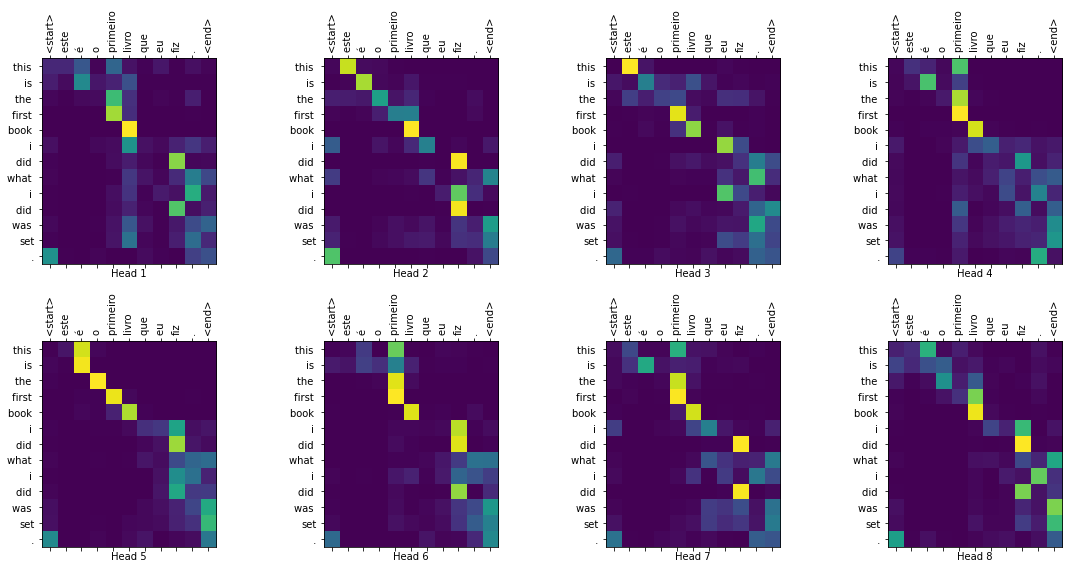
Real translation: this is the first book i've ever done.
まとめ
このチュートリアルでは、位置エンコーディング、マルチヘッド・アテンション、マスキングの重要性と、 Transformerの作成方法を学習しました。
Transformerを訓練するために、異なるデータセットを使ってみてください。また、上記のハイパーパラメーターを変更してベースTransformerやTransformer XLを構築することもできます。ここで定義したレイヤーを使ってBERTを構築して、SoTAのモデルを作ることもできます。さらには、より良い予測を得るために、ビームサーチを組み込むこともできます。
